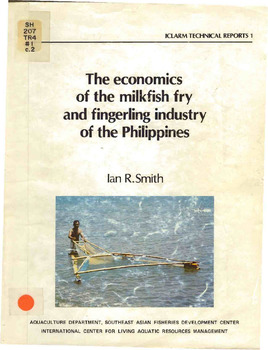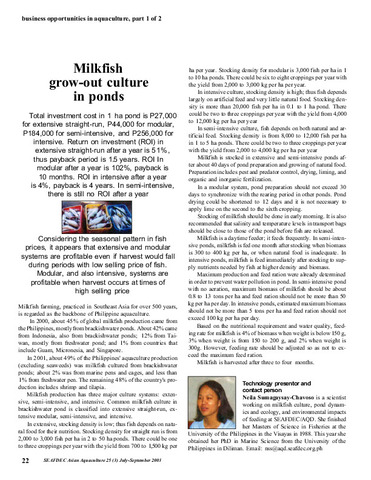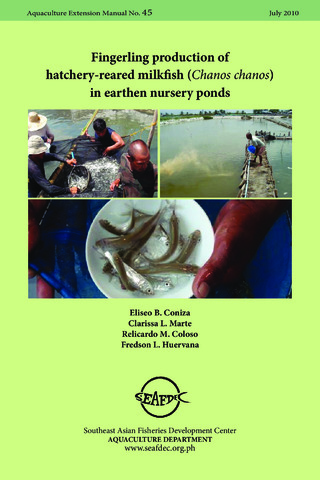The economics of the milkfish fry and fingerling industry of the Philippines
- Global styles
- MLA
- Vancouver
- Elsevier - Harvard
- APA
- Help

View/
Date
1981Author
Page views
10,823AGROVOC keyword
Taxonomic term
Metadata
Show full item record
Share
Abstract
The fry and fingerling industry of the milkfish (Chanos chanos Forskal) in the Philippines is alleged to suffer from certain imperfections. Primary among these are an annual shortage of catch necessary to meet the stocking requirements of the 176,000 ha of fishponds; high fry mortality rates during transp0rt;failure of the pricing system to perform its spatial and form allocative functions; and exploitation of fry gatherers and pond operators by middlemen and nursery pond operators who form the core around which the whole fry and fingerling industry has developed. These alleged imperfections provide the rationale for various government policies affecting the fry and fingerling industry.
This study indicates a higher level of industry performance than hitherto supposed. In 1974, an estimated 1.35 billion fry were caught, adequate to meet annual stocking requirements. Allegations of fry shortage were based on simultaneous underestimation of catch and overestimation of stocking requirements, and were traced to temporary price increases resulting from expanded fishpen area, which subsequently declined. Fry storage and transport mortality rates of 8.7% and 6.6%, respectively, compared with a mortality rate of 54% during rearing, indicated that major technical inefficiencies arise in fishponds rather than in the distribution system. Of every 100 fry caught, 38 are harvested at marketable size.
Monthly average fry prices among 17 major trading regions were significantly correlated, indicating a high level of information flow in the industry. An examination of the concession system which restricts first sale opportunities of gatherers indicated that concessionaires are unable to capture their full monopsony advantage due to the "competitive fringe" of smugglers. Rather than exploitation, the concession system is a form of indirect municipal tax on fry gatherers.
Since the fry industry is a 57-million-peso-per-year industry upon which approximately 170,000 people directly and indirectly depend, it is suggested that the location of future milkfish hatcheries and timing of production be planned such that they complement rather than displace the natural fry fishery and distribution system.
Suggested Citation
Smith, I. R. (1981). The economics of the milkfish fry and fingerling industry of the Philippines. Metro Manila, Philippines: International Center for Living Aquatic Resources Management ; Iloilo City, Philippines: Aquaculture Department, Southeast Asian Fisheries Development Center.
Type
Book; Technical ReportISSN
0115-5547Series
ICLARM technical reports; 1 | SEAFDEC Aquaculture Department contribution; No. 93Format
xiii, 148 p. : ill. ; 28 cm.
Collections
Related items
Showing items related by title, author, creator and subject.
-
Milkfish grow-out culture in ponds
Sumagaysay-Chavoso, Neila (Aquaculture Department, Southeast Asian Fisheries Development Center, 2003)Milkfish farming is regarded as the backbone of Philippine aquaculture. In 2001, nearly 50% of the Philippines' aquaculture production was milkfish cultured from brackishwater ponds. It has 3 major culture systems: extensive; ... -
Series: Aquaculture extension manual No. 45
Fingerling production of hatchery-reared milkfish (Chanos chanos) in earthen nursery ponds
Coniza, Eliseo B.; Marte, Clarissa L.; Coloso, Relicardo M.; Huervana, Fredson L. (Aquaculture Department, Southeast Asian Fisheries Development Center, 2010)Fingerling production of milkfish in ponds maybe operated as a commercial enterprise or a component of milkfish farming that comprises nursery, transition and rearing or grow-out phases. The fishpond nursery is used to ... -
Price relationships in Philippine milkfish markets: Univariate and causality analysis
Salayo, Nerissa D. (International Association of Aquaculture Economics and Management (IAAEM), 2006)Uncertainties and lack of information on milkfish product prices, along with production-related problems with inputs, generally constrain efficient resource use in milkfish grow-out operations. Milkfish growers complain ...






